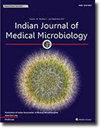通过肠杆菌重复基因间共识-聚合酶链反应从血流感染中分离出万古霉素耐药肠球菌的分子谱:一项来自印度东北部的前瞻性横断面研究
IF 1.4
4区 医学
Q4 IMMUNOLOGY
引用次数: 0
摘要
目的肠球菌已成为引起菌血症的重要原因,常常导致严重的并发症,如感染性心内膜炎。万古霉素耐药肠球菌(VRE)的增加对肠球菌菌血症的治疗提出了重大挑战,特别是在医院环境中。本研究旨在对某三级医院血液样本中分离的VRE菌株进行分子表征和基因分型。方法本前瞻性横断面研究于2021年8月至2024年12月在印度东北部特里普拉的一家三级保健医院进行。收集成人和儿童患者的血液样本,并按照部门规程进行培养和微生物鉴定。评估分离肠球菌的药敏,通过VRE筛选确定对万古霉素耐药。Real-time PCR检测VRE基因,ERIC-PCR分型。结果共分析了626份血样,其中263份(42%)呈阳性。肠球菌排在第三位(21.7%),主要是粪肠球菌(63.2%)。多数病例来自ICU(52.6%)和内科(49.1%)。利奈唑胺的敏感性为100%,万古霉素的敏感性为75.4%。环丙沙星耐药性最高(敏感性44%)。检出VRE 14株(24.6%),均携带VanA基因。ERIC-PCR鉴定出3个聚类,大多数分离株(n=11)属于聚类III,包括ATCC对照菌株。结论本研究强调了印度东北部一个州引起血液感染的肠球菌的流行、耐药模式和分子特征。钒酸钠介导的耐药性的优势及其在重症监护环境中的聚集性要求立即关注感染控制和有针对性的抗微生物策略。未来的研究应侧重于促进该地区医院和社区环境中VRE传播的环境和流行病学因素。本文章由计算机程序翻译,如有差异,请以英文原文为准。

Molecular profiling of vancomycin-resistant enterococci isolated from bloodstream infections by enterobacterial repetitive intergenic consensus-polymerase chain reaction: A prospective cross-sectional study from Northeast India
Purpose
Enterococcus spp. Has emerged as a significant cause of bacteremia, often leading to severe complications such as Infective Endocarditis. The rise of Vancomycin-Resistant Enterococci (VRE) poses a critical challenge in treating Enterococcal bacteremia, particularly in hospital settings. This study aims to conduct molecular characterization and genotyping of VRE strains isolated from blood samples in a tertiary care hospital.
Methods
This hospital-based prospective cross-sectional study was conducted at a tertiary care hospital in Tripura, Northeast India, from August 2021 to December 2024. Blood samples from both adult and pediatric patients were collected and processed for culture and organism identification following departmental protocols. Antimicrobial susceptibility of isolated Enterococcus spp. Was assessed, and vancomycin resistance confirmed through VRE screening. Real-time PCR was employed for VRE gene detection, and ERIC-PCR was used for genotyping the VRE strains.
Results
During the study, 626 blood samples were analyzed, with 263 (42 %) testing positive for pathogens. Enterococcus spp. Was the third most common isolate (21.7 %), predominantly E. faecalis (63.2 %). Most cases originated from ICU (52.6 %) and the Medicine Department (49.1 %). Linezolid showed 100 % sensitivity, while Vancomycin had 75.4 % sensitivity. Ciprofloxacin exhibited the highest resistance (44 % sensitivity). VRE was detected in 14 strains (24.6 %), all carrying the VanA gene. ERIC-PCR identified three clusters, with most isolates (n=11) in Cluster III, including the ATCC control strain.
Conclusion
This study highlighted the prevalence, resistance patterns, and molecular characteristics of Enterococcus spp. Causing bloodstream infections in a Northeast Indian state. The predominance of VanA-mediated resistance and its clustering in critical care settings call for immediate attention to infection control and targeted antimicrobial strategies. Future research should focus on the environmental and epidemiological factors contributing to the spread of VRE in hospital as well as community settings in the region.
求助全文
通过发布文献求助,成功后即可免费获取论文全文。
去求助
来源期刊

Indian Journal of Medical Microbiology
IMMUNOLOGY-
CiteScore
2.20
自引率
0.00%
发文量
154
审稿时长
73 days
期刊介绍:
Manuscripts of high standard in the form of original research, multicentric studies, meta analysis, are accepted. Current reports can be submitted as brief communications. Case reports must include review of current literature, clinical details, outcome and follow up. Letters to the editor must be a comment on or pertain to a manuscript already published in the IJMM or in relation to preliminary communication of a larger study.
Review articles, Special Articles or Guest Editorials are accepted on invitation.
 求助内容:
求助内容: 应助结果提醒方式:
应助结果提醒方式:


